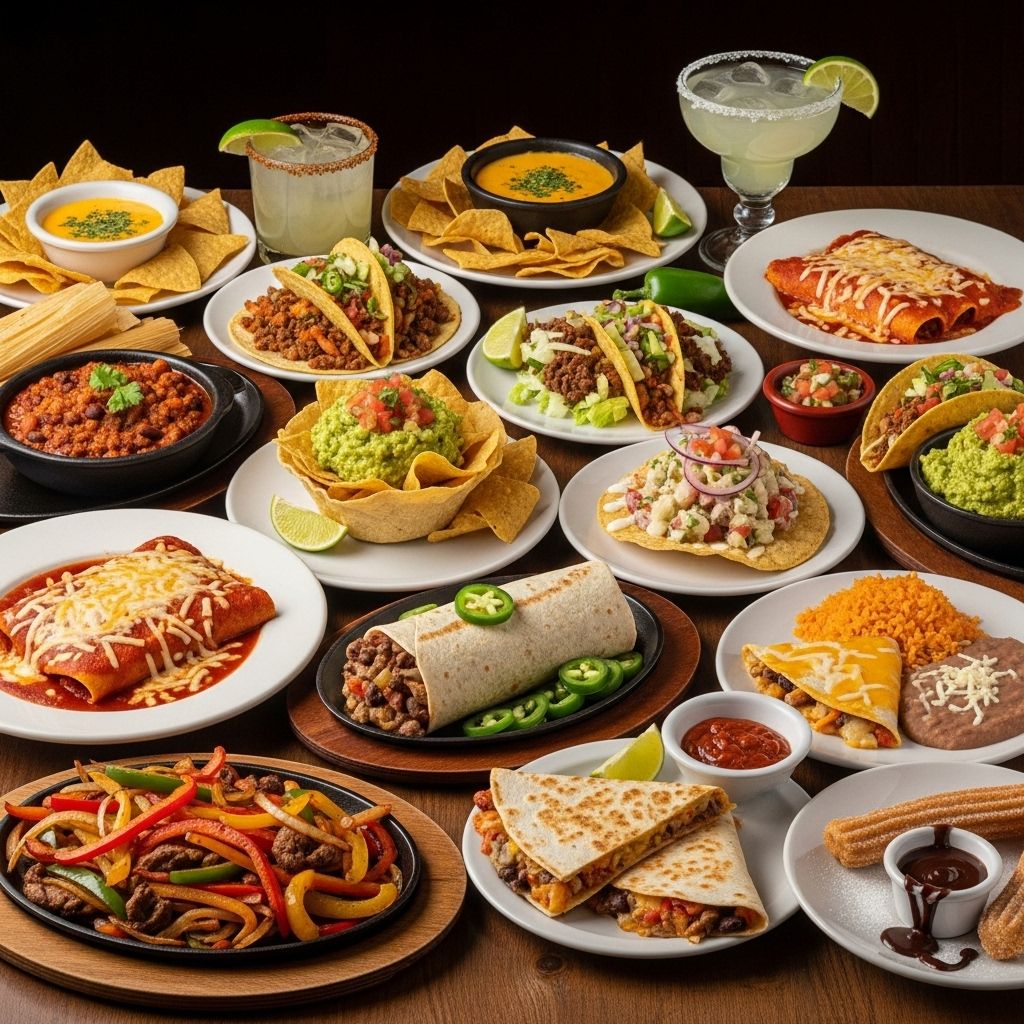The Essential Guide to Tex-Mex Dishes Everyone Must Try
Each recipe tells a spicy tale of border-born innovation and irresistible comfort.

Tex-Mex cuisine—born from the blending of Mexican culinary traditions and Texan influences—has become a pillar of American comfort food. From sizzling fajitas to cheesy enchiladas, these iconic dishes offer bold flavors, hearty satisfaction, and a storied history that speaks to generations of home cooks and restauranteurs. This guide explores the defining plates of Tex-Mex, explaining their roots, ingredients, and what sets them apart. Whether you’re seeking dinner inspiration or interested in food history, these must-try classics illustrate why Tex-Mex is beloved nationwide.
What is Tex-Mex?
Tex-Mex is a regional cuisine that melds Mexican traditions and Texas cooking. While originating along the Texas-Mexico border, its hearty portions and liberal use of cheese, beef, and flour tortillas have made it a staple in American restaurants far beyond its birthplace. Defining features include:
- Cheese: Melted, shredded, or saucy, cheese is pervasive in Tex-Mex dishes.
- Flour Tortillas: Used just as often as corn.
- Ground Beef: Replaced some traditional Mexican proteins.
- Ample Seasonings: Cumin, chili powder, and garlic are common for bold, pronounced flavors.
Though inspired by Mexican cuisine, Tex-Mex has its own identity and beloved classics. Below we detail its most essential dishes, their histories, and tips for enjoying them.
Core Tex-Mex Dishes
Chili Con Carne
Arguably the dish that launched Tex-Mex into mainstream popularity, chili con carne is a robust, beef-based stew featuring chili peppers, tomato, and fragrant seasonings like cumin and garlic. It is often topped with shredded cheese and diced onions, and served with tortilla chips or rice. This Texan dish has inspired chili cook-offs and variations around the country.
- Main Ingredients: Beef, chili peppers, tomatoes, cumin, garlic.
- Variations: Beans are often added outside Texas, though the traditional version omits them.
Fajitas
Sizzling fajitas arrived on restaurant menus in the 1980s and quickly became iconic. Originally composed of grilled skirt steak, modern variations use chicken, shrimp, or vegetables. Served on a hot skillet with bell peppers and onions, fajitas are built at the table—wrapped in flour tortillas and topped with salsa, guacamole, or sour cream.
- Common proteins: Steak, chicken, shrimp.
- Toppings: Guacamole, cheese, pico de gallo, sour cream.
Enchiladas
Enchiladas feature corn or flour tortillas rolled around a filling (beef, chicken, or cheese), then baked under a blanket of spicy sauce and melted cheese. Tex-Mex enchiladas are typically topped with chili gravy—a distinctive brown sauce flavored with chili powder and flour, rather than the lighter Mexican red sauce.
- Core fillings: Beef, chicken, cheese, beans.
- Classic Sauce: Chili gravy, often with cumin and chili powder.
Nachos
No Tex-Mex gathering is complete without a mound of nachos: tortilla chips covered in melted cheese and toppings. The original nachos, invented in the 1940s in Piedras Negras, Mexico (just over the Texas border), were simple: tortilla chips with melted cheese and pickled jalapeños. Today, nachos come loaded with beans, ground beef, salsa, guacamole, and sour cream.
- Essentials: Chips, melted cheese, jalapeños.
- Loaded Varieties: Refried beans, seasoned ground beef, tomatoes, onions, sour cream.
Tacos (Crispy and Soft)
Tacos are the workhorse of Tex-Mex, coming in both crispy shell and soft tortilla versions. Hard shell tacos are a Tex-Mex innovation, filled with seasoned ground beef, lettuce, tomatoes, and shredded cheese. Soft tacos use flour tortillas and similar fillings, sometimes swapping ground beef for grilled chicken or steak.
- Shell Types: Crispy corn, soft flour.
- Popular Fillings: Ground beef, chicken, steak, lettuce, tomato, cheese.
Burritos
While burritos originated further west, large stuffed burritos have become Tex-Mex staples. Typically built with flour tortillas, burritos are filled with beans, seasoned beef or chicken, rice, and plenty of cheese, then rolled tight for easy eating. Smothered burritos—covered in sauce and baked—are signature Tex-Mex comfort food.
- Key ingredients: Refried beans, rice, seasoned proteins, cheese.
- Serving styles: Wrapped or smothered with sauce.
Queso
A must-order at any Tex-Mex restaurant, queso is a molten cheese dip, often spiked with chopped tomatoes, green chilies (especially Ro-Tel), or ground beef. Queso is served with tortilla chips and is frequently the centerpiece of parties and gatherings. Unlike Mexican queso fresco, Tex-Mex queso is gooey and best enjoyed warm.
- Ingredients: Melted cheese (often Velveeta), tomatoes, chilies, sometimes ground meat.
Breakfast Tacos
A true Texan tradition, breakfast tacos come stuffed with combinations like potato, egg, cheese, and chorizo—all nestled in a soft flour tortilla. Whether wrapped for a to-go snack or served as part of a big breakfast, these tacos are hearty, savory, and markedly different from breakfast burritos farther west.
- Fillings: Eggs, potatoes, chorizo, cheese, peppers.
- Common toppings: Salsa, pico de gallo, hot sauce.
Tamales
Tamales carry deep roots in Mexican culinary history but are often featured in Tex-Mex feasts, especially around holidays. Corn dough (masa) encases fillings like shredded pork or spiced beef, then wrapped in corn husks and steamed. Tex-Mex variations lean toward spicier fillings and generous servings of sauce or cheese.
- Main filling: Pork, beef, or chicken.
- Encasement: Corn masa, steamed in corn husks.
Tex-Mex Rice (Red Rice)
Served alongside nearly every entree, Tex-Mex rice—or red rice—is cooked with tomato puree, onions, garlic, and chicken broth for mild, savory flavor. Often peas and carrots are added for color and texture. Though simple, it completes the Tex-Mex plate alongside refried beans.
- Key flavors: Tomato, onion, garlic.
- Optional additions: Peas, carrots, bell peppers.
Refried Beans
Refried beans (frijoles refritos) are another cornerstone of the Tex-Mex table, often served on the side or as a nacho topping. Pinto beans are simmered, mashed, and then fried in lard or oil for a creamy, rich taste starring in burritos and plate combos.
- Main ingredient: Pinto beans.
- Cooking method: Simmered, mashed, and sauteed.
Chimichangas
A chimichanga is essentially a deep-fried burrito, filled with Tex-Mex staples like shredded beef, beans, and cheese, then fried until golden and crispy. Topped with sour cream, guacamole, or pico de gallo, it’s a rich and satisfying indulgence.
- Core fillings: Beef, chicken, beans, cheese.
- Texture: Crispy exterior, gooey interior.
Frito Pie
Frito pie transforms snack chips into main dish magic: a bag of Fritos topped with chili con carne, shredded cheddar cheese, and onions. Served in cafeterias, stadiums, and home kitchens, its crunchy, cheesy, and meaty appeal is an ode to Tex-Mex inventiveness.
- Base: Frito corn chips.
- Toppings: Chili, cheese, onions, jalapeños.
Texas Caviar
Created in the 1940s, Texas Caviar combines black-eyed peas with chopped peppers, onions, garlic, and a tangy vinaigrette. Sometimes served as a dip with tortilla chips, its fresh crunch provides a counterpoint to richer Tex-Mex mainstays.
- Main ingredient: Black-eyed peas.
- Toss-ins: Bell peppers, onions, garlic, vinaigrette.
Birria Tacos
Though Mexican in origin, birria tacos have swept through Tex-Mex menus in recent years. Beef is slow-cooked with a blend of dried chiles and spices, shredded, and served in dipped, griddled tortillas accompanied by a rich consommé for dipping. Decadent and spicy, birria has become a viral favorite.
- Core elements: Shredded beef, chile broth, griddled tortillas.
- Serving style: Tacos and broth for dipping.
Tex-Mex Staples: Salsas, Tortillas, and Sides
Restaurant-Style Salsa
Bright, tangy, and always present, restaurant-style salsa pairs tomatoes, onions, cilantro, jalapeño, lime, and salt for a zesty dip. Served with tortilla chips, it’s the customary opener for any Tex-Mex meal.
- Main ingredients: Tomatoes, onions, cilantro, jalapeño.
- Variations: Roasted or raw, chunky or smooth.
Corn
Corn, either as tortillas, chips, or tamale masa, is foundational. While flour tortillas are preferred for many Tex-Mex dishes, corn tortillas carry deep Mexican heritage and remain prevalent in regional cooking. Elote (street corn), with cheese, chili, and lime, is increasingly popular on Tex-Mex menus.
Comparing Tex-Mex to Mexican Cuisine
| Tex-Mex | Traditional Mexican |
|---|---|
| Flour tortillas, more cheese | Corn tortillas, less cheese |
| Beef and chicken heavy | Pork, seafood, wider variety |
| Chili gravy and loaded sauces | Fresh salsas, mole, pipian |
| Americanized toppings | Traditional local produce |
Tex-Mex at Home: Pantry Essentials
- Tortilla chips and flour tortillas
- Shredded cheeses: Cheddar, Monterey Jack
- Refried pinto beans
- Canned tomatoes and chiles (Ro-Tel)
- Ground beef or chicken breast
- Spices: chili powder, cumin, garlic powder
Equipped with these staples, you can recreate Tex-Mex favorites—from nachos and enchiladas to vibrant salsa and cheesy queso—right in your own kitchen.
Frequently Asked Questions (FAQs)
Q: What makes Tex-Mex different from Mexican food?
A: Tex-Mex uses more cheese, flour tortillas, and ground beef. It tends toward hearty, bold flavors and larger portions, whereas Mexican cuisine sticks closer to local produce, corn tortillas, and distinct regional traditions.
Q: Are beans essential in Tex-Mex?
A: Yes. Refried pinto beans are a mainstay, appearing in burritos, nachos, and as standard sides.
Q: Why is chili con carne so closely associated with Texas?
A: Chili con carne originated in Texas as a simple stew of beef and chili peppers, gaining popularity through chili parlors and cook-offs. The use of beef and strong seasoning exemplified Texan innovation.
Q: What cheese is most used in Tex-Mex?
A: Cheddar and Monterey Jack are most common, valued for meltability and rich flavor, whether in queso, nachos, enchiladas, or tacos.
Q: Is Tex-Mex spicy?
A: Individual dishes vary, but many feature moderately spicy flavors from jalapeños, chili powder, and salsas. Spiciness can be adjusted with toppings.
Conclusion: The Enduring Appeal of Tex-Mex
Tex-Mex remains a beloved cornerstone of American eating thanks to its comforting, crowd-pleasing nature and irresistible flavor profiles. From smoky chili con carne to crispy chimichangas, these dishes showcase skilled adaptation and culinary fusion. With simple pantry staples and robust ingredients, you can bring Tex-Mex classics to your own table—celebrating both their deliciousness and the cultural history behind each bite.
References
Read full bio of Shinta












